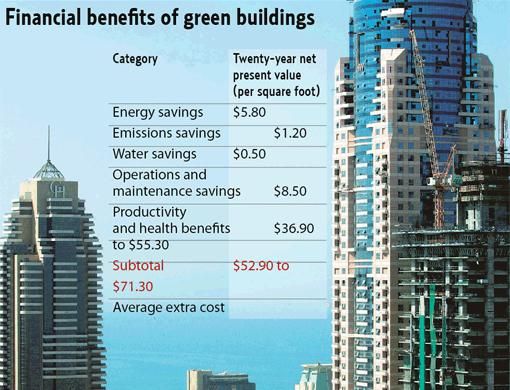Dubai: The right mix of appropriate design and greater use of energy saving technologies can substantially reduce carbon dioxide (CO2) emissions from the building sector, which accounts for 30-40 per cent of global energy use, according to the world's top building expert.
"With rapid urban development worldwide, dense and more concentrated cities are widely seen now as an essential part of a more sustainable way of life," said Antony Wood, executive director of Council on Tall Buildings and Urban Habitat (CTBUH).
"These dense, smaller-footprint cities can cut energy consumption and climate-change emissions by reducing the suburban spread of cities, and therefore the need for extensive transportation and infrastructure networks.
"In this regard, tall buildings play a key role in creating denser cities by accommodating more people on smaller parcels of land and therefore reduce the overall impact of buildings upon the environment and upon the world's climate."
According to Wood, tall buildings can be reinvented to address the need for both a dense and sustainable city by creating vibrant, mixed-use facilities within both the building and the city as a whole.
"Tall buildings need to innovate beyond their standard functions: office, residential, and hotel space - that account for around 95 per cent of space in tall buildings worldwide - to include more sustainable functions," he said.
Innovative designs
For example, research conducted by the CTBUH into alternative design approaches has resulted in a number of innovative buildings forms such as vertical farms to help alleviate the problems of agricultural imports, and vertical aquifers to maximise rainwater capture, which will help address the growing global decline of water resources. Tall buildings must also be able to accommodate more social-communal spaces within them, such as skygardens and skyplazas.
"While there are those who believe that the embodied energies involved in tall buildings combined with the impact on the urban realm, make them inherently anti-environmental, I believe that the opposite is true," Wood said.
"The biggest impact on a building's energy consumption is the fundamental early decisions that are taken in the building's design, in respect of size, form, shape, skin and the positioning of cores etc - all relative to the environment: sun, wind, light. Moreover, tall buildings provide a great potential for harnessing wind energy; more efficient energy production and distribution systems and an increased access to view, light and air."
In the Gulf, which is experiencing some of the world's fastest growth rates in construction, the need for more sustainable patterns of life as a response is becoming more and more critical. According to recent studies, the construction boom in the Gulf alone has reached new heights, with 2,837 projects estimated to be worth in excess of Dh8.8 trillion ($2.4 trillion) now under way.
Carbon footprint
"The UAE, for example has the highest carbon footprint in the world with almost 9.06 global hectares per person, closely followed by Kuwait with 6.38 global ha/person and the USA with 5.66 global ha/person. The main challenge for these countries is to move directly to more energy efficient building solutions," said Wood.
In general, green buildings provide financial benefits that conventional buildings do not. On average, green buildings use 20-30 per cent less energy - a saving of about Dh220 ($60) per year for a 100,000 square foot building.
A recent report from Massachusetts Technology Collaborative said: "The financial benefits of green buildings are between $50 and $65 per square foot. These benefits are in lower energy, waste and water costs, lower environmental and emissions costs, and lower operational and maintenance costs."













